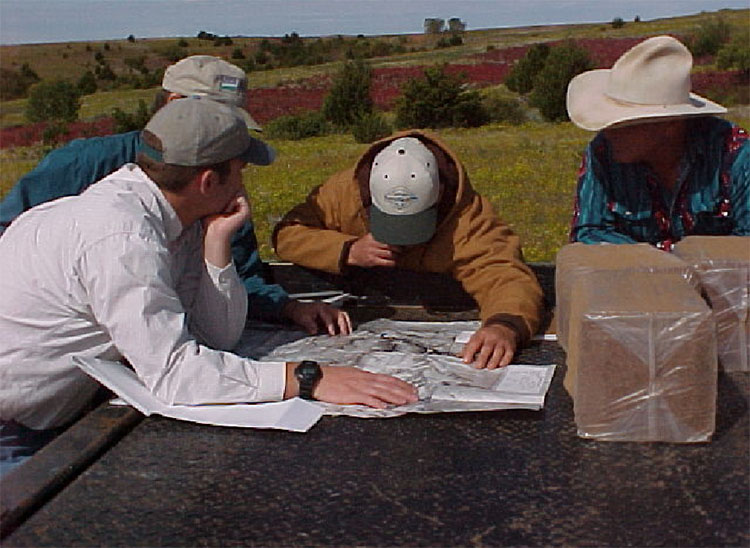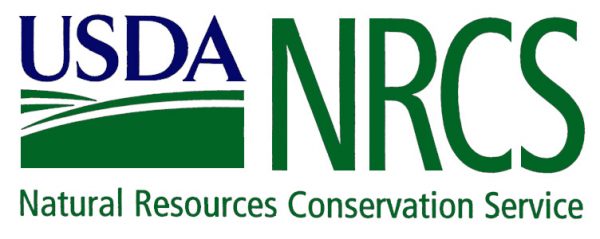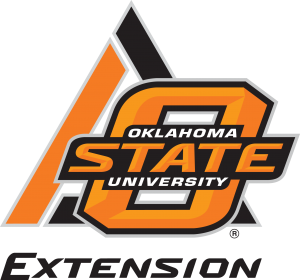Management After Wildfire
What can Landowners do to manage property after a wildfire?
Has your property been affected by wildfire? Are you unsure about what to do now and who to turn to for help?
Wildfires can be devastating to personal property, such as homes, barns, hay bales or standing grass used for winter forage. However, the effects of wildfires on vegetation are similar to the effects of prescribed fire. In many cases, wildfires provide valuable control of eastern redcedar and other woody plants that have increased in coverage because of fire suppression.
The information contained in this publication includes land management practices that
may be used by landowners to implement after experiencing wildfire on their property.
Depending on many factors, the impacts of wildfires will vary between individual landowners
and areas impacted.
The Natural Resources Conservation Service (NRCS) and Oklahoma Cooperative Extension
Service are available to answer questions and provide assistance to landowners in
dealing with wildfires.
For information on prevention and protecting property such as homes or outbuildings,
refer to the Firewise Website at: www.firewise.org/home.
Impacts of Fire
Many people don’t understand the role of fire on the land. When wildfires roll across the countryside, the primary thought is that of total loss and devastation, especially when coping with the loss of homes and barns. Landowners who rely on grasslands, shrublands and forests as an income (grazing, haying, timber production and recreational leasing for wildlife) are faced with the question of “What do I do to recover the vegetation and habitat that I rely on?” Even though the initial appearance on the land is that of a moonscape, devoid of most vegetation, these lands will recover naturally.
Fire has been, and still is, an essential part of maintaining healthy native grassland,
shrubland and forest ecosystems and has positive impacts. In fact, fire applied in
a prescribed manner is a valuable management tool used by many Oklahoma farmers and
ranchers to restore and maintain healthy plant communities. Oklahoma’s native ecosystems
are fire dependent and, without fire, these plant communities become dysfunctional
and unproductive.
Prescribed fire is the use of fire applied under specific conditions and appropriate
planning, which allows the fire to be confined to a specific area to accomplish a
planned land management objective. Prescribed fire is used to improve the health,
appearance, recreational value and productivity of the land. By using prescribed fire,
landowners can restore and maintain forests, shrublands and grasslands as diverse,
healthy ecosystems and reduce wildland fuels loads. Wildfires are unplanned fires
that occur unintentionally any time conditions are favorable for their spread. To
put these fire types in perspective, from 2002-2016 Oklahoma averaged almost 164,000
acres burned annually by wildfire. While at the same time, there are more 1.5 to 2
million acres burned with prescribed fire in this state every year.
Fire suppression has also caused a dramatic increase in wildland fuel load. Combining
the increased fuel loads with extreme weather conditions (high wind, low humidity,
high temperatures) and drought is a recipe for severe wildfires, which can burn thousands
of acres. Each year, wildfires become more common and more difficult to control in
some areas because of an increase in wildland fuels. Reducing wildland fuel will not
eliminate wildfire potential, but will reduce potential loss of homes, keep firefighters
safer and lower suppression costs. Wildfire danger to firefighters and homeowners
is magnified by the presence of volatile fuels, like eastern redcedar. Firefighters
should not have to fight fire in areas invaded by eastern redcedar, but it is present
on many poorly managed lands throughout the state.
Although landowners can apply prescribed fire to reduce potential for wildfires on
their land, sometimes land may be located in areas where fire, even when applied in
a prescribed manner, may not be practical. Other methods of protecting property from
wildfires include installation of firebreaks around the perimeter of the property
or important structures and facilities; keeping lawns and other areas mowed short;
and removal of volatile fuels, such as eastern redcedar.

Vegetation Recovery
After a wildfire, it may appear as if the flames have destroyed all vegetation. This loss of vegetation not only affects its use for livestock feed and wildlife cover, but often causes concern about soil erosion by wind and water. Vegetation helps control erosion by shielding the soil from the impact of raindrops and slowing the amount and velocity of runoff and impacts from wind. But we should remember that even though the tops of plants are gone, the crowns and roots are still intact holding the soil in place. In sandy soils, some soil movement has been experienced following wildfires, but studies following intense fire and even heavy grazing show that no blowouts or drifts were observed or created. After examining many wildfire sites in subsequent years, no negative impact caused by this minimal movement of soil were observed.

Many landowners also are left with the fear that vegetation will not return unless it is re-seeded. However, in all but the most extreme cases, like small areas under brush piles, plants are still alive and will recover. Factors that affect recovery time after wildfire include types of plants and their adaptation to fire, fire intensity and residence time, precipitation (before and after the fire), soil type, previous history of grazing and fire, season of fire and current management.
Fire has played a key role in the development of Oklahoma’s landscape and plant communities
respond favorably to fire. Most of our native trees, shrubs, forbs and grasses have
mechanisms of coping with fire. Some will grow new leaves; some will re-sprout from
their roots, while others have fire-resistant seeds that will sprout following a fire.
Plants are most susceptible to fire when they are actively growing. For warm season
plants, this would be during the summer months and for cool season plants, the winter
months. Bunchgrasses like little bluestem accumulate dead material above the root
crown and the center of the plant dies over time. After a fire, it sometimes appears
that the plant was killed when, in fact, the center of the plant was already dead.
This can be observed by examining burned and unburned plants in the same area. In
contrast, rhizomatous grasses or those with underground stems that spread, such as
big bluestem, have growing points below the soil surface and do not accumulate fuel
next to the root crown. Most of our common native grasses like little and big bluestem,
bluegrama, buffalograss, sideoats grama and Indiangrass are extremely fire tolerant,
usually recovering within one growing season and often producing more forage than
unburned areas when adequate rainfall is available during the growing season. These
species have taken as long as three years to recover when fire is followed by severe
drought conditions for multiple years, but unburned plants are not growing much then
either. Woody plants are adapted to fire by the location of buds or protective bark.
Most woody plants resprout from the plant crown or roots if top growth or apical buds
are killed. Once apical dominance is lost, dormant basal buds below the soil surface
begin growth. Many of our native shrubs like sand sagebrush, shinnery oak, sumac and
sandplum are very fire tolerant, providing wildlife habitat within a growing season
after wildfire. Some woody plants, such as eastern redcedar, lack basal buds and do
not resprout. Many woody plants have thick bark and are adapted to intense fire. Eastern
cottonwood, post oak and shortleaf pine are examples of fire-tolerant trees.
Management prior to wildfire will also affect recovery time. Proper grazing management
resulting in healthy plants (identified by an abundance of plants, seeds, root crowns
and rhizomes) prior to wildfire will help ensure healthy, vigorous recovery and growth
afterwards. Native perennial grasses, like big bluestem, can have root systems that
reach depths of 8 or 9 feet. Even shortgrasses, like buffalograss, which matures at
4 to 6 inches aboveground can have roots as deep as 5 feet. Heavy grazing, when more
than half of the plant leaf weight is removed, can reduce both the amount of roots
a plant grows and it’s ability to hold soils in place.
If there is concern that the plant community will not recover, a field evaluation
can be made to determine what, if any, action is needed. This is best done at the
end of the growing season after the wildfire when plants have had an opportunity to
grow and reproduce.

Management Following the Wildfire
Following a wildfire, management practices need to be applied to encourage desired
plant growth. The desired plants will depend on the objective of the landowner. For,
example, an increase in forbs or broadleaves (weeds) will benefit many wildlife species
and not affect grass growth or livestock production. Broadleaf annual plants are often
the first to start growing following any disturbance and are a natural part of revegetation
or plant succession. Allowing these plants to grow and thrive is critical for recovery
and plays an important role in providing soil cover. Remember, many plants referred
to as weeds are palatable and eaten by livestock and are valuable to wildlife.
If grazing is planned on burned areas, grazing management practices, like sustainable
stocking rates and periodic rest, need to be applied to promote the growth and vigor
of the desired plant community.

Management considerations following a wildfire include:
- Some areas may need to be deferred from grazing until plant growth is adequate to support it. This will be dependent on precipitation. Remember—if it doesn’t rain, plants will not grow whether burned or unburned.
- In pastures that were partially burned, apply prescribed fire to the remaining unburned portion to keep livestock from continually over-utilizing the burned area.
- Always use proper stocking rates.
- Alter season of use by avoiding the same areas and plants at the same time each year.
- Rotate livestock between pastures to allow plant recovery before being re-grazed. This may need additional practices, such as temporary fencing and new water facilities.
- With adequate precipitation, areas can be grazed with intensive early stocking (IES). In this system, twice as many animals are grazed for half the growing season (April 1 to June 30). The key is to remove cattle by July 1, if using IES and not graze the area again until after frost.
- Utilize rotation of salt, mineral and feeding locations to better distribute grazing.
- Weeds (forbs) will appear, but they will also diminish with time after fire. Types of weed control include: herbicides (very expensive when compared to net profits per acre); flash grazing or intensive early stocking with cattle (most economical if proper pull-off date is used); or mowing (most expensive). Weed control is usually not economical in terms of cattle gains, based on a number of experiments done during the past 10 years at the pasture level. A lot of the information that assumes increased productivity for cattle was done on small plots without cattle grazing. If weed control is used, it will have a negative impact on wildlife food and habitat.
- Monitor to ensure management decisions are encouraging desirable plant growth.
- Be careful when feeding hay, especially hay brought in from other regions. This hay may contain invasive plants or red imported fire ants. Limit hay-feeding areas and monitor the area during recovery. Treat invasive plants as needed.
- Apply fertilizer according to a soil test for introduced species, such as bermudagrass.
- Apply individual tree ignition of eastern redcedar not fully burned by the wildfire.

Assistance after the Wildfire
The information provided in this publication is meant to provide some guidance in helping landowners make decisions following wildfire events. The impacts of wildfire will vary in each situation, as will the course of action and management needed. The key is to not overreact. All of Oklahoma’s ecosystems are fire dependent, therefore they are adapted to all kinds of fire.
For further assistance in evaluating your land and planning practices to address concerns
following a wildfire, contact the local NRCS or Oklahoma Cooperative Extension Service
office. Offices are located in every county in Oklahoma and are listed in phone books
under federal and state government.

This publication was developed as a joint project between the Natural Resources Conservation Service and Oklahoma Cooperative Extension Service.
All programs and services of the Natural Resources Conservation Service are provided in a nondiscriminatory manner.
The U.S. Department of Agriculture (USDA) prohibits discrimination in all its programs and activities on the basis of race, color, national origin, age, disability, and where applicable, sex, marital status, familial status, parental status, religion, sexual orientation, genetic information, political beliefs, reprisal, or because all or a part of an individual’s income is derived from any public assistance program. (Not all prohibited bases apply to all programs.) Persons with disabilities who require alternative means for communication of program information (Braille, large print, audiotape, etc.) should contact USDA’s TARGET Center at (202) 720-2600 (voice and TDD). To file a complaint of discrimination write to USDA, Director, Office of Civil Rights, 1400 Independence Avenue, S.W., Washington, D.C. 20250-9410 or call (800) 795-3272 (voice) or (202) 720-6382 (TDD). USDA is an equal opportunity provider and employer.
Steve Glasgow
State Grazing Lands Specialist
USDA-Natural Resources Conservation Service
Terrence G. Bidwell
Professor emeritus, Extension Rangeland Ecology
and Management Specialist
John R. Weir
Research Associate, Natural Resource Ecology and Management
Laura E. Goodman
Range Extension Specialist and Assistant Professor



